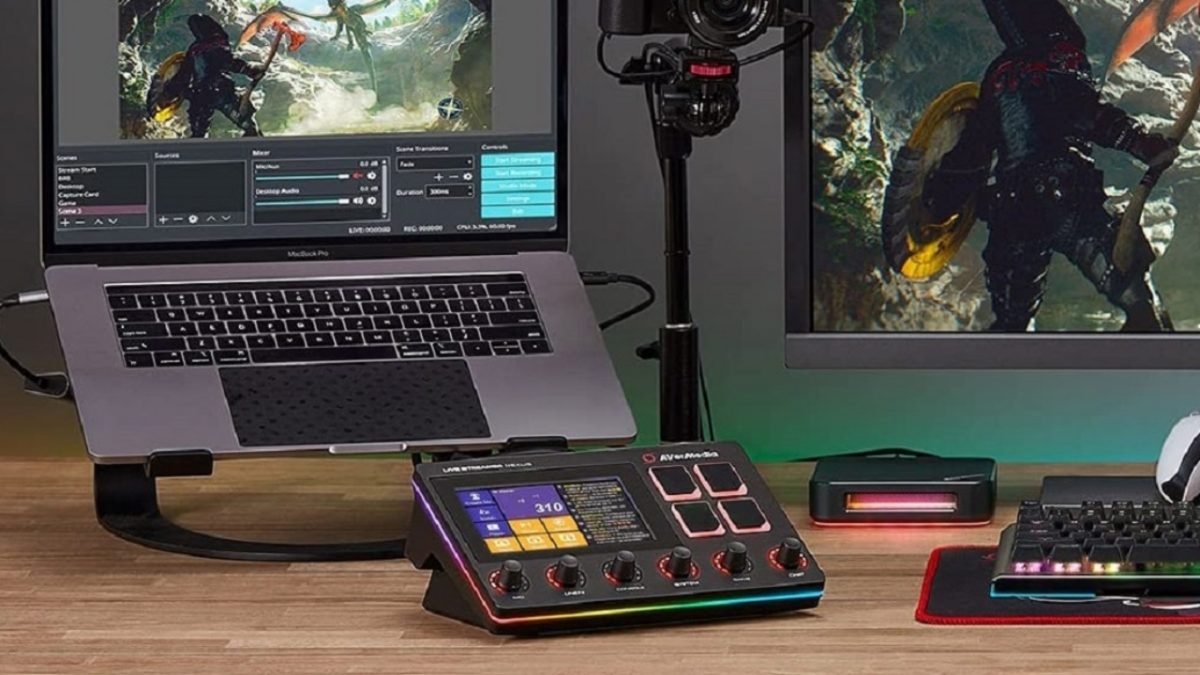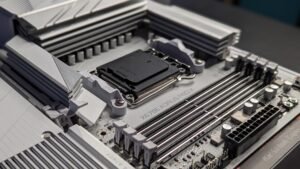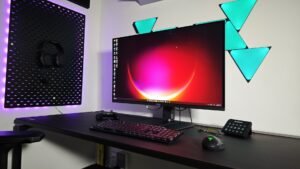Gear for content creators, streamers in particular, has come by leaps and bounds in the last few years. Thanks to their ease of use, Control hardware like the Stream Deck and the Loupedeck have revolutionized the way streams are presented and audio solutions (both hardware and software) like TC Helicon’s GoXLR or Elgato’s Wave Link Software have taken audio mixing to the next level.
What is left on the table by these devices, however, is quite literally everything. Desk space can be limited and the need for multiple devices takes up a lot of it. That’s where AVerMedia comes in with their Live Streamer Nexus, with dedicated audio controls and customizable space to control any aspect of your content.
Out of the box, the Nexus is a beautiful, hulking piece of hardware, but it is as big as it needs to be. With all the IO (inputs/outputs) on this thing and the fact that it is doing several jobs, the size of this device is in no way an issue. At first glance, all you really see is that AVerMedia made a truly beautiful piece of hardware.

The Nexus has six audio control knobs meant to separately control and mix the most common sources for any content creator, Microphone, Line In, Console, System, Game and Chat. The question comes to mind, “isn’t is console the same game??” In this case, no, as the Nexus has a separate optical input for game consoles, and the “Game” knob is an assignable input via your software, most likely used for PC games.
Also, on the front are four touchpads and a large touch screen that are all customizable for any use in the software. On the back, you will find all the IO that you could possibly dream of. There is a headphone jack, a line out for speakers, a recording device or to run to a second PC if you are running a 2 PC stream, an XLR input for your microphone, a line in for an external device, optical cable for your console (as previously mentioned) and the USB connection for your PC.
“Out of the box, the Nexus is a beautiful, hulking piece of hardware, but it is as big as it needs to be.”
An early red flag for me when getting ready to set this up was seeing a USB-B connection for this relatively new device. This means that the Nexus is not USB powered like its competitors and therefore needs an additional cable to supply power to the device. For the sake of cutting down on cable clutter and just due to the fact that we are living in the 2020s, I would have liked to see a USB-C cable sending power to the hardware.
Another beautiful addition to the controller is a removable magnetic stand that is built beautifully and secures so well to the Nexus that it feels like one solid piece but is still so easy to remove or put on. Removing the stand makes the Nexus lay flatter on your desk, but not completely. Whether you have it on or not is simply a matter of preference, but it’s the little things like this that really round out the hardware.

There is also a lot of RGB customisability on the Nexus as well. You can change the colours to match your personal aesthetic, which is great. What is cooler is that you can use the RGB as an indicator of a loss of connection to other software/platforms which can help you resolve an issue sooner than trying it and having it fail on you.
The Nexus does some on-board audio processing, taking some strain off your computer, including a simple three band Equalizer, a noise gate, compression, and reverb. It’s a distinct advantage over other controllers that were not specifically designed for audio and an advantage over software mixers, which use the processing power of your computer to accomplish the task.
“What is cooler is that you can use the RGB as an indicator of a loss of connection to other software/platforms…”
Setup was particularly challenging for me. Before I share this, I do want to disclaim that these experiences are not ones that I have found to be consistent with other people’s accounts of setting up their Nexus but are certainly worth consideration as it uncovers some consistent issues that I have personally experienced when reviewing AVerMedia Products.
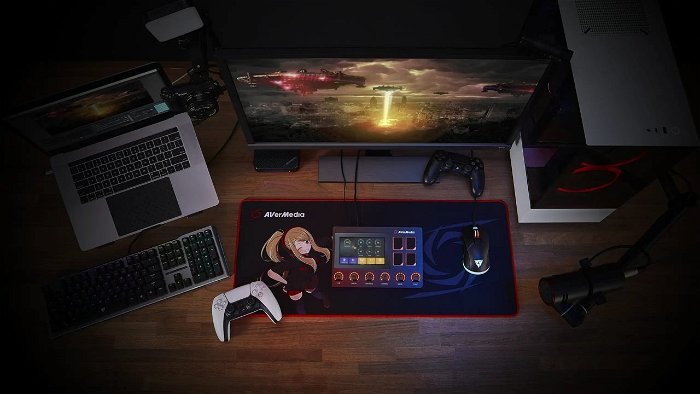
The setup was anything but plug and play, which I was expecting, given the complexity of the device and the knowledge that accompanying software was required for the hardware to function, but this was probably the most frustrating process I have encountered in my time as a reviewer. The software installation and updates seemed to be going off without a hitch, but when I went to hear my microphone for the first time, I heard nothing.
While tinkering with the Nexus, I found that I was able to hear the other sources just fine and only the XLR input appeared to be producing no audio. I searched through the settings to ensure that nothing was impeding the audio and that it was set up for my microphone, I checked to see if I was experiencing issues with my mic or cable by switching them out and, in the end, it was an arbitrary combination of restarting the AVerMedia AX310 software and turning the Nexus on and off again that got it up and running. This took nearly an hour to resolve.
The next, much stranger issue, was when I completely lost the use of my keyboard at the end of the software setup. This was an issue that took me two nights to solve, and the resolution was uninstalling all of my AVerMedia Software. I again disclaim that I highly doubt that an issue like this will be your experience if purchasing the Nexus, but it points out one issue I always seem to have with AVerMedia, their software.
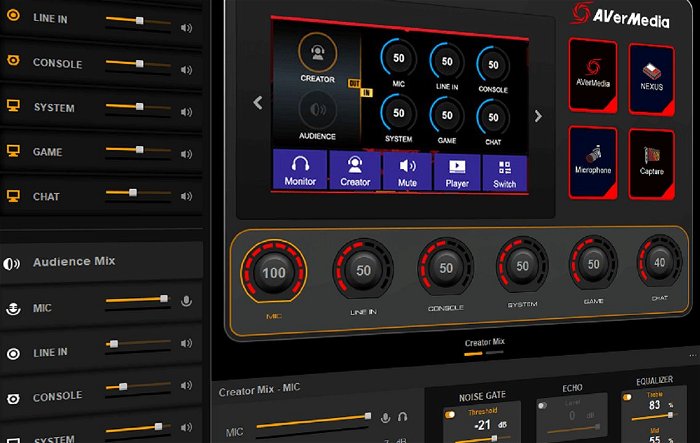
And, while it isn’t an issue so much as an inconvenience, the Nexus requires OBS_websocket to integrate properly with OBS Studio. While you can still broadcast your audio in OBS without the plugin, you wouldn’t be able to take advantage of any of the device’s control capabilities, which would make much of the functionality of the Nexus useless on the most used streaming software. The need for these plugins is just another potential barrier when it comes to you going live.
When software is needed for a piece of hardware, the number one priority of the developers of said software needs to be creating a user-friendly interface that is easy to set up so that the software enhances the hardware experience. AVerMedia’s software, The CamEngine, VoiceEngine or, in this case, the AX310 software have all caused me issues getting the hardware working right away and, once I have gotten past those issues, the user interface just seems counterintuitive or is just missing something.
“AVerMedia’s software, The CamEngine, VoiceEngine or, in this case, the AX310 software have all caused me issues getting the hardware working right away…”
The frustrating thing with this software is that they got so much right. They were almost there. All previous issues aside, the touch screen contains a simple, widget-based setup that allows you to add anything from controls for your stream to additional audio controls to stream stats from Twitch and YouTube. Not only this, but you aren’t constrained to a single page, you can swipe through the pages and create multiple setups to use.
The touchpads are just as easily programmable with any of the aforementioned control options as well. They even offer a submix, allowing you to send one audio mix to your viewers and a separate mix to your headphones, which can be crucial for a creator who needs less music in their ears and more game audio, or louder chat than they are sending to their audience. They are not the first to release this type of feature, but it is really one of my must-haves in a system like this now that we know it can be done.

Where the “almost there” of it all comes in is in the execution. For the submixes, rather than creating a simple system where the faders for the two mixes are side by side so that they can be easily compared or linked, they’ve created a system wherein you have to enable the submix, then the two mixes are separate from each other.
You cannot link certain sources, so they are always the same going to both you and the audience and still leave the flexibility of changing other sources. It really is all or nothing. You can try to match up the mixes on each source, but the faders’ lack of proximity to each other makes it hard to get it just right.
There was also an inconsistency in the information on the software compared to what was on the hardware. Changing the gain on any of the audio sources via the knob would stop registering on the software, which didn’t seem to recognize that any change was made (the levels were being changed, just not being indicated). A streamer needs to be able to trust their displays when trying to run a broadcast.
At just under $400 USD, it is a relatively comparable price to a combination of devices that you could buy to do the same job, but you have to weigh if the potential issues are worth the trade-off saving real estate on your desk. One thing that the Nexus has going for it, though, is that it is a good update away from being everything you hoped for. You can choose to buy into this now and have faith that the company will come through with the fix or if you want to wait to see if they come through.
